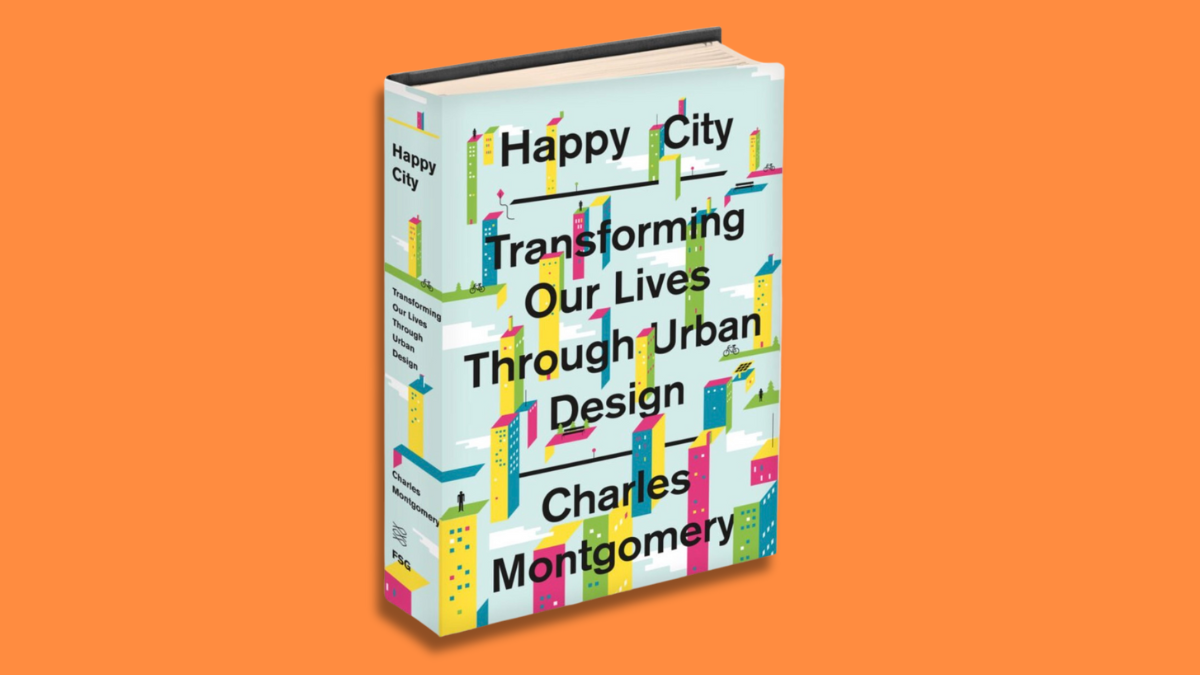By guest contributor Alison Grover. She recently wrote about bike parking.
I recently had the pleasure of reading, Happy City: Transforming Our Lives Through Urban Design by Charles Montgomery (Farrar Straus & Giroux, 2014). I savored almost every one of its 313 pages. Read this book if you care about the design of our built environment.
The author, Charles Montgomery is an award-winning writer, researcher, and urbanist from Vancouver, British Columbia. He draws on his experiences living in Vancouver as well as his travels. Although this book was published over ten years ago, the ideas presented remain salient and valuable.
Happy City is a collection of research and anecdotes illustrating what it means to live in a city that’s conducive to human happiness. Throughout the book, we learn about urban design, psychology, and neuroscience, getting to the heart of what produces joyful city residents. In a nutshell: it’s all about our social connections.
One insight that resonated with me was a highlight on Mark Lakeman and The City Repair Project, a Portland-based placemaking group. You’ve probably either heard of them or seen their work in colorful, painted intersections around town. These were started as a response to Portland’s urban grid, where, “in most neighborhoods, the streets themselves became the only shared public space…[the grid] has a profound effect on the people who must inhabit it: it estranges them from the process of shaping their own world” (p. 305). Many times, I have wondered why sidewalks are practically the only public spaces in my southeast Portland neighborhood. Where is our gathering space? Parks, street plazas, and food truck pods offer informal, convivial public space; but we need more, especially on the east side, in order to get to know our neighbors and build ownership of our communities.
Montgomery illustrates both the social isolation of living in dispersed suburbs, and conversely, the stress induced by ultra high-density apartment style living. He suggests that the happiest density lies somewhere in between. An ideal medium density would have enough people to support services, transit, and walkability, while keeping building heights below a couple of stories.
This book reads more like a novel rather than a manual on urban design. Montgomery doesn’t simply bombard us with research insights from the fields of design and psychology. Rather, he delivers information at the human scale for an enjoyable reading experience in the same way that human scale cities make for enjoyable lives. As the reader, you become invested in peoples’ stories while gaining insight from the experiences of a super-commuter in Northern California, a co-housing community in Vancouver, BC, and cramped apartment residents in New York City, to name a few.
Throughout the book, Montgomery builds trust by going further than quoting urban planners, architects, politicians, and psychology experts. He’s cycling alongside Jan Gehl in Copenhagen. He’s chasing Enrique Penalosa around Bogota on a mountain bike. He’s chatting with Eric Britton while navigating Paris traffic on a bike. His writing is well-researched and well-rounded.
Overall, I would recommend this book to those interested in convivial public spaces, walkable communities, meeting one’s neighbors, combatting social isolation, and democratizing housing and transportation. I hope you gain as much from it as I did. Happy reading!
Alison Grover has a master’s degree in Landscape Architecture and has been biking in Oregon since 2017.



